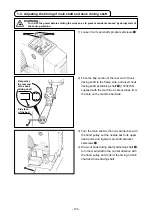
– 113 –
1-14. Troubles and corrective measures (Sewing conditions)
Trouble
Cause
Corrective measures
Page
1. The needle
thread slips off
at the start of
bar-tacking.
①
Stitches are slipped at the start.
②
The needle thread remaining on
the needle after thread trimming
is too short.
③
The bobbin thread is too short.
④
Needle thread tension at 1st
stitch is too high.
⑤
Thread clamp is unstable (mate-
rial is apt to be expanded, thread
is hard to slide, thread is thick,
etc.).
⑥
Pitch at 1st stitch is too small.
◦
Adjust the clearance between the needle
and the shuttle to 0.05 to 0.1 mm.
◦
Set soft-start sewing at the start of bart-
acking.
◦
Correct the thread tension release timing
of the thread tension controller No. 2.
◦
Increase the tension of the thread take-
up spring, or decrease the tension of the
thread tension controller No. 1.
◦
Decrease the tension of the bobbin
thread.
◦
Increase the clearance between the
needle hole guide and the counter knife.
◦
Decrease the tension at 1st stitch.
◦
Decrease the number of rotation at 1st
stitch at the sewing start. (Extent of 600
to 1,000 sti/min)
◦
Increase the number of stitches of
thread clamp to 3 to 4 stitches.
◦
Make the pitch at 1st stitch longer.
◦
Decrease the needle thread tension at
1st stitch.
103
85
12
11
107
85
86
85
2. Thread often
breaks or syn-
thetic fiber thread
splits finely.
①
The shuttle or the driver has
scratches.
②
The needle hole guide has
scratches.
③
The needle comes in contact with
the work clamp.
④
Fibrous dust is in the groove of
the shuttle race.
⑤
The needle thread tension is too high.
⑥
The tension of the thread take-up
spring is too high.
⑦
The synthetic fiber thread melts due
to heat generated on the needle.
⑧
When taking up thread, thread is
pierced with needle tip.
◦
Take it out and remove the scratches
using a fine whetstone or buff.
◦
Buff or replace it.
◦
Adjust the position of the work clamp.
◦
Take out the shuttle and remove the
fibrous dust from the shuttle race.
◦
Reduce the needle thread tension.
◦
Reduce the tension.
◦
Use silicone oil.
◦
Lower the needle bar height from the
engraved marker line by a half of the line
to as much as the line.
◦
Check the rough state of needle tip.
◦
Use the ball-pointed needle.
11
12
115
3. The needle often
breaks.
①
The needle is bent.
②
The needle comes in contact with
the work clamp.
③
The needle is too thin for the
material.
④
The driver excessively bends the
needle.
◦
Replace the bent needle.
◦
Adjust the position of the work clamp.
◦
Replace it with a thicker needle accord-
ing to the material.
◦
Correctly position the needle and the
shuttle.
9
103
4. Threads are not
trimmed.
(Bobbin thread only)
①
The counter knife is dull.
②
The difference in level between
the needle hole guide and the
counter knife is not enough.
③
The moving knife has been im-
properly positioned.
④
The last stitch is skipped.
⑤
Bobbin thread tension is too low.
⑥
Flopping of cloth
⑦
Pitch of the last stitch is small.
⑧
Hole of the needle hole guide is
small.
◦
Replace the counter knife.
◦
Increase the bend of the counter knife.
◦
Correct the position of the moving knife.
◦
Correct the timing between the needle
and the shuttle.
◦
In crease the bobbin thread tension.
◦
Lower the intermediate presser height of
the last stitch.
◦
Make the clearance between presser
and needle small.
◦
Decrease the stroke of the intermediate
presser.
◦
Make the pitch of the last stitch large.
◦
Replace the needle hole guide with one
with larger hole.
106
103
106
115




































